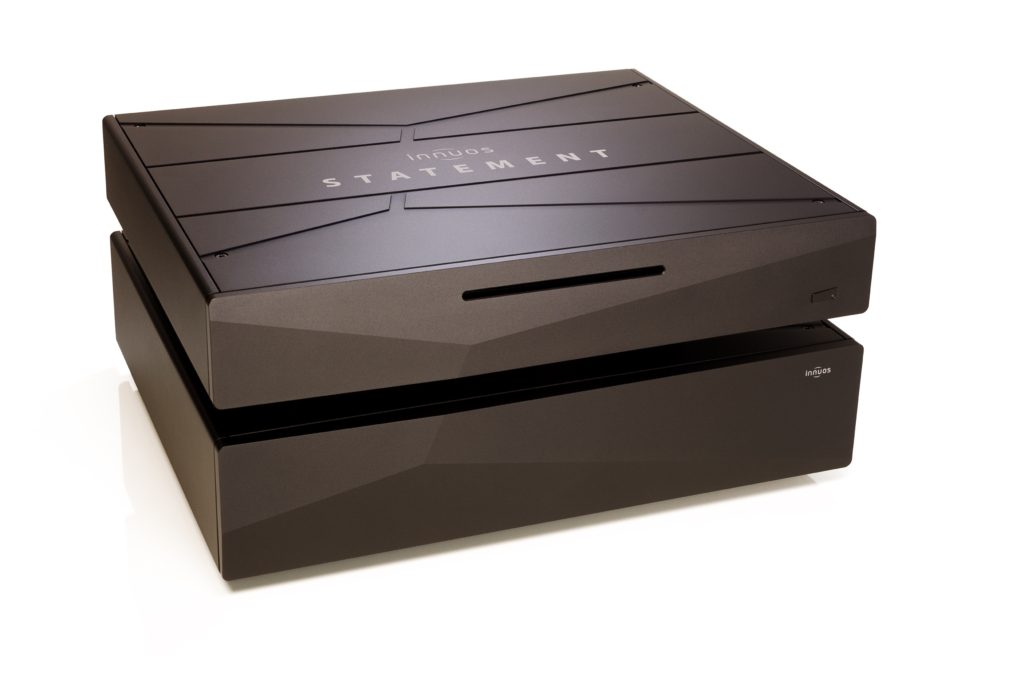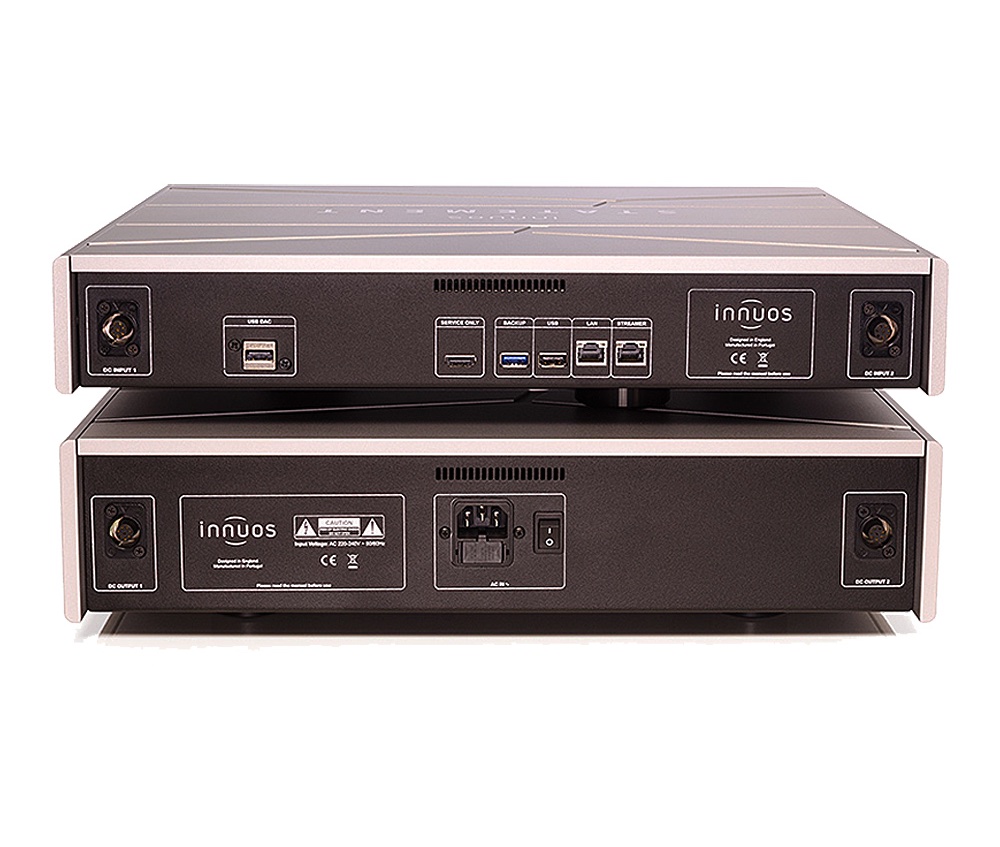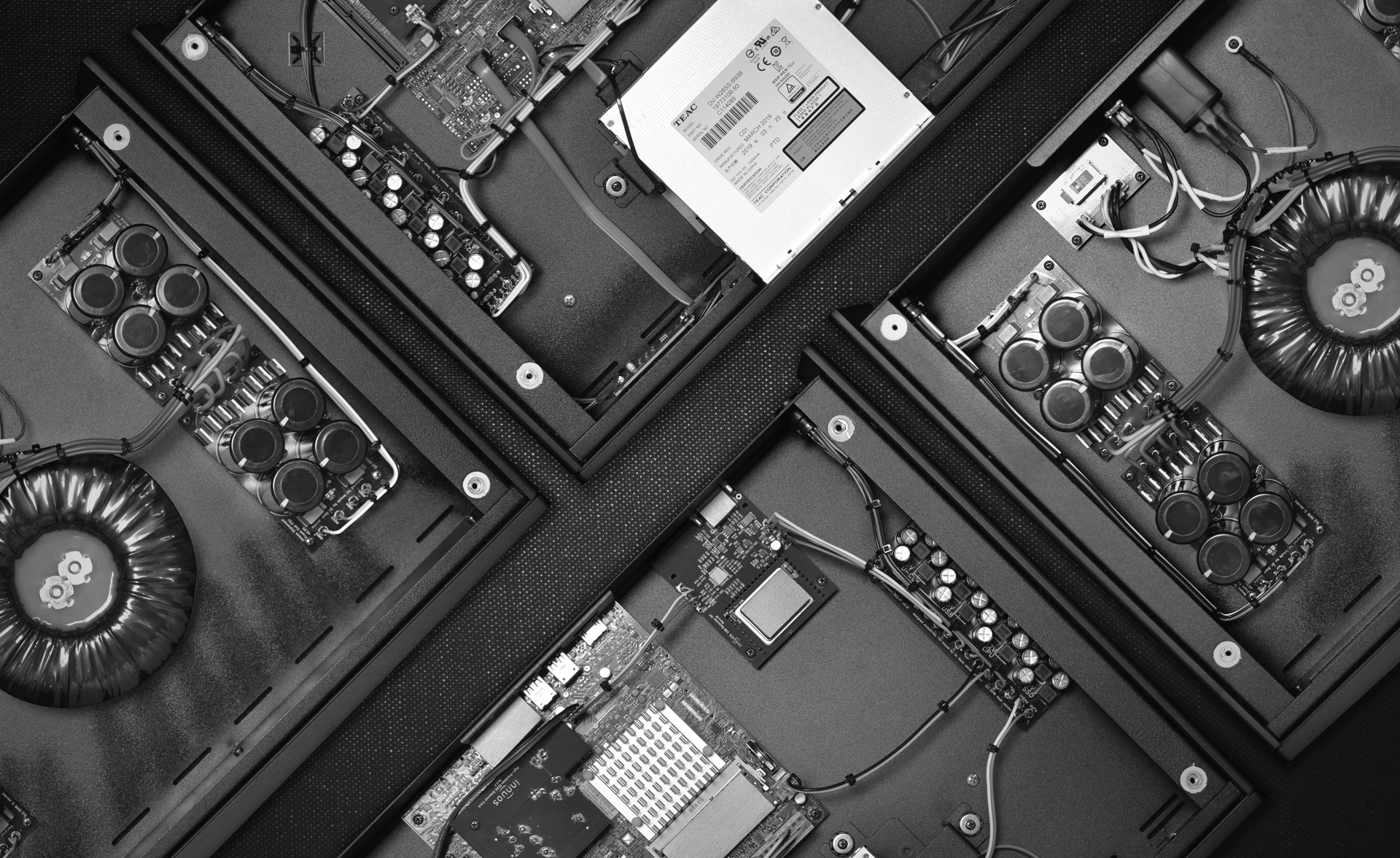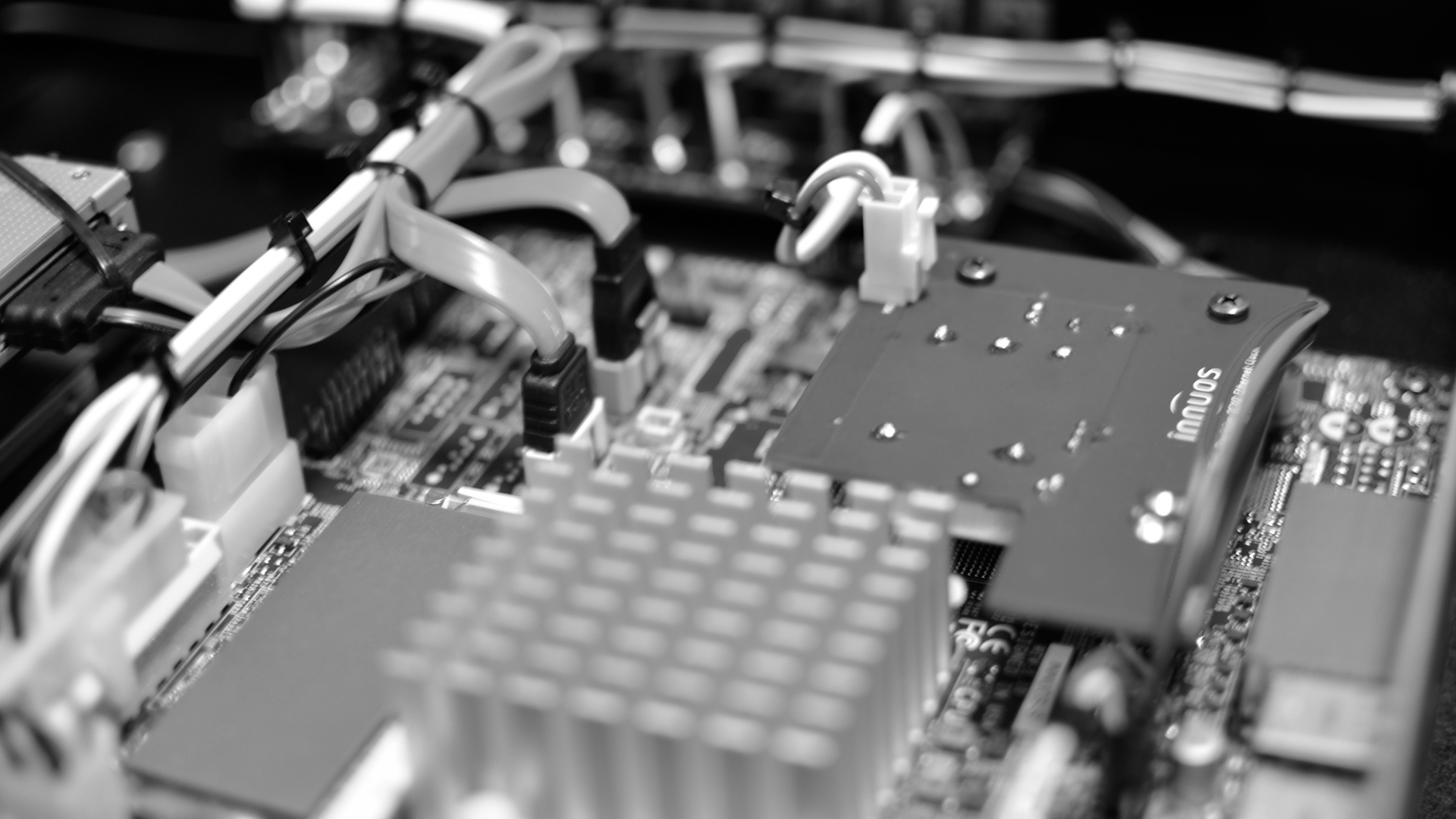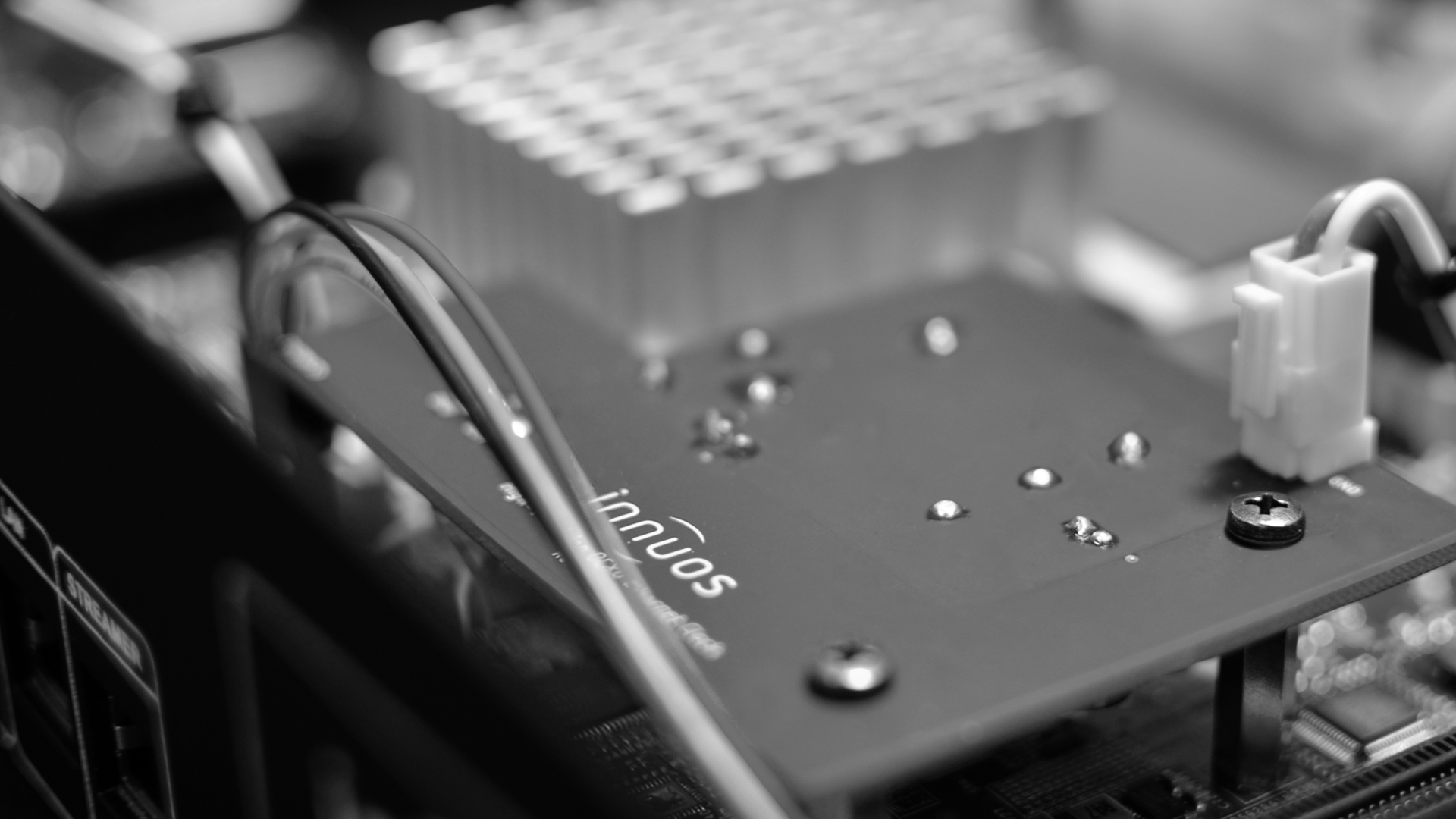You will never meet a friendlier pair of software engineers than Nuno Vitorino and Amelia Santos of Innuos. They met in 1994 as university students and later married. Like many, their entry into the audio business began in their garage when Nuno built a music server. He was pleased enough with the unit to build a few and offer them on eBay. He knew he had something special when he sold 200 in six months, and Innuos was born.
It’s no surprise when good people partner with good people, and that’s the case with Nuno and Amelia who hired Mark Sosa as their representative in the United States. Mark owns Well Pleased Audio Vida out of Virginia and also represents Vinnie Rossi, QLN Speakers, and others. If you haven’t heard one of his rooms at an audio show you should look for him the next time you attend a show. Mark’s room competes with and sometimes betters the big boys that have the mega systems in the board rooms. Mark gets the credit for introducing me to the Innuos brand.
Description of the Innuos Statement
The Statement, which comes in both a black and a silver finish, looks a lot like other Innuos gear, plus an extra box. The truth is that the casework has been changed. The drive slot used to add music has been moved to the center front of the unit and the styling is more modern. The top of the box also has distinctive styling which presumably adds rigidity as well as aesthetic appeal.
The bottom case is more than a power supply. In my interview with Nuno, he explained the power supply this way, “We partnered once again with Dr. Sean Jacobs to help us design a new power supply architecture. It was designed exclusively for the Statement. The power supply is not simply the bottom unit; it is distributed between two units. The bottom unit contains the AC/DC conversion stage. The top case contains the SSD storage and the custom motherboard that is designed to minimize EMI noise. There are eight DC power rails, each with double regulation resulting in 16 regulators in all. Four of the power5 rails are for the motherboard, with one each for the SSD storage, Ethernet clock, USB clock, and for the USB 5V.
Why go to all this trouble? To be able to have very short signal paths to obtain the cleanest power regulated power possible this architecture is much more efficient compared to traditional architecture with the power supply in a separate chassis. The motherboard has been EMI-optimized to our own exclusive design. This results in not needing any noise-generating components that compromise audio. We designed and built the USB and Ethernet reclocking devices in-house with their own boards for this purpose.”
A Mini Thought Piece from The Beatnik
All of this information about the design may sound like overkill, but it got me thinking. Most of you know that I have been a devoted “vinylphile” for practically all of my life. I tried the CD format when it first came out but it just wasn’t very musical to me. The only exception to this was SACD, but in the end there just wasn’t enough music that I wanted available on this wonderful format.
During the ‘90s, people were astounded that I still had a turntable and LPs. The most common comment was, “How can you stand all the noise on records?” I would answer honestly that most of my records were quiet because I had always handled them carefully. Then I would tell them that in my not so humble opinion the noise from wear on a record sounds like it is extraneous. It’s more like there is noise in the room than noise in the playback of the recording. On the other hand, digital recordings seemed to have lots of noise in the recording itself that mask detail and micro-dynamics. This noise left me feeling very fatigued after listening for just 30 to 45 minutes.
Now, I see I was wrong. The noise wasn’t in the recordings, it was in the playback equipment. You can hear the difference in noise reduction starting with the Innuos ZENmini, and it becomes as clear as day with the Statement. It turns out that there is plenty of music in those early digital recordings. It has just taken many years and some brilliant engineers to deliver it to us. Well, now back to the review.
Review System for the Innuos Statement
Here’s a breakdown of the components I used for this review. The speakers were the ElectrostaticSolutions QUAD ESL 57s, powered by a pair of Butler Audio MONAD 100 monoblocks, and I used the LTA MicroZotl 3 preamp.
The Innuos Statement server replaced my Innuos Mini3 with Linear power supply and was used with the BorderPatrol DAC. I will also be reviewing the Statement with the Lampizator Golden Atlantic DAC, and the PS Audio DirectStream DAC. All of the cabling was Audience FrontRow. The power distributor was the HB Cable Design’s Marble PowerSlave.
My System and the Innuos Statement
From almost the moment I touched play on my iPad Pro, I knew the Statement was never leaving my system. The big question is, why does it make such a difference?
As an LP guy for most of my life, I am reminded of essentially the same question about turntables. All a turntable needs to do is turn an LP at a certain speed and keep that speed completely steady. The only other thing it needs to do is not vibrate. It never made any sense to me why the turntable makes a bigger difference than the tonearm or cartridge, at least in my opinion.
The same seems to be the case with the server versus the DAC in my digital system. This discovery made the $13,750 price of the Statement seem downright reasonable in comparison to world-class turntables.
I started my review of the Innuos ZENmini Mk3/LPS by saying, “Guess what, there really is music hidden in those digits! Until the Innuos ZENmini Mk3 showed up in my listening room, this ‘dyed in the wool’ vinyl lover didn’t really believe that.” Well, that was true, but until I heard the Statement I had no idea how much music was there to be heard in my home. If I had to pick one word to sum up how my system sounded with the Statement in it, that word would be “more”.
More Like Music
I did not say it sounds musical; the word musical carries too much baggage. In no way am I saying it sounds really warm and smooth. It’s simple. What I am saying is that with the Statement, drums sounded more like drums, cymbals sounded more like cymbals and so forth. The tone, timbre, and harmonics of instruments sounded more like real instruments.
A singer’s voice is both the most difficult and the easiest instrument to make sound realistic on a recording. If it is well recorded, a solo folk singer accompanied by an acoustic guitar can make a budget system sound great. On the other hand, singers like Rhiannon Giddens, one of my favorites, can really test the limitations of your system. Many systems simply cannot hold it together as her voice becomes more intense and powerful and at a louder volume.
There are a lot of things I don’t understand about servers, and about this server in particular. For example, how does the Innuos Statement play her voice and that of other singers without falling apart at volumes above what my ears can take? Also, why am I able to hear many more nuances from both male and female voices? While I don’t know the answers, I do know that all of this leads to my system sounding more like music and less like a hi-fi.
More Frequency Extension
With the Statement, I also heard my system play some of the most beautiful treble notes I have ever heard from a pair of QUAD ESL 57s, and they can play some beautiful treble. The bass plays deeper, with more power, more definition, and more air and decay from the instruments themselves. Like I said above, drums just sound more like drums, stand up basses sound like they’re standing in your room being played or on the stage where they were recorded.
The frequency extension is especially easy to hear when listening to a piano. I have never heard my system come anywhere close, not even with analog, to making a piano sound so real from the deepest bass notes to the extreme treble notes. It did not matter whether it was Bach, Jazz piano, or even a ragtime pianist, it simply sounded just right and very beautiful.
More Drive, Power, and Dynamics
I was also shocked by the dynamic range of my system with the Statement providing the source. The dynamic range in every way exceeded my expectations. I know that dynamic range is supposed to be one of the hallmarks of digital reproduction, but that has not always been my experience. I have heard very few systems that could match the dynamic range of the DS Audio Master One Cartridge System, for example.
Not only did my system have more dynamics overall, it simply sounded more powerful. The difference was apparent and easily heard by anyone. This power gave the music much more drive and musical flow resulting in a more alive and real sound. I had never heard this sound from a digital system, and it matched most vinyl rigs.
Much More Information
After listening for only an hour or so, it was apparent. I knew I was hearing much more information than I had heard before from a digital source. For example, I could hear more of the leading edge and the decay of strings and percussion instruments. I could also hear more of the air and space around the instruments.
This increase in information produced a much more coherent and holistic soundstage. This was, as would be expected, much more apparent on live recordings. Let’s be honest, on studio recording we are hearing the sound space the recording engineer wants us to hear. Listening with the Statement, however, it didn’t matter if it was a symphony orchestra, a jazz quartet, or a rock recording. It simply sounded more like I was there at the event.
I Could Enjoy Music More
Finally, and most importantly, with the Statement, I enjoyed listening to music more. The combination of the Innuos Statement music server and the BoarderPatrol DAC played jazz, vocals, rock, bluegrass, and classical music in a way that could be beautiful and relaxing, or it could play music that had raw power, drive and punch. Best of all, I enjoyed its ability to draw me into the music and involve my emotions.
Remember all of the listening for this review was with the BoarderPatrol DAC. So, none of the listening was done with real hi-rez or DSD files. I have a brand new Statement ordered, and I will be adding it to my personal system soon.
My next review will be of the Statement with the Lampizator Golden Atlantic DAC, and then I plan to review it with the PS Audio DirectStream DAC. So, stay tuned to hear more. Let me close by saying the Innuos Statement has done more to change my opinion of digital music reproduction than anything has before. Like I said earlier, it let me discover that there is a lot of music in those digits. I had just never heard it before.

